There’s nothing like a big win to get people excited. And thus, with Arsenal’s 2-0 victory over Manchester United, the footballing world is looking rather more kindly on Unai Emery’s first season at the Emirates. With eight games remaining, the team is just one win away from equalling last season’s points total. A year-to-year improvement in terms of results is all but a done deal. It’s all looking good for the Spaniard, but how much have they really improved, what has changed, and are things moving in the right direction? The bad news is, when looking at the expected goal trendlines since the start of last season, there have been plenty of ups and downs, but it’s not obvious that Emery has significantly improved things from Arsène Wenger’s last year in charge. 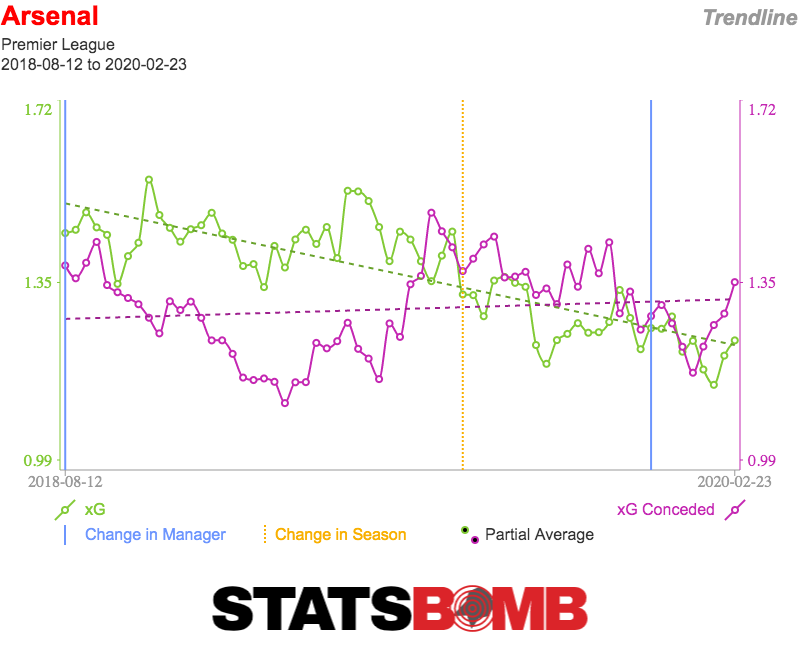 On the attacking end, Arsenal’s xG per game is down a smidgen from 1.54 to 1.45. Defensively, things have barely changed at all, moving from 1.23 xG conceded per game last year to 1.25 today. As you’ve probably worked out already, Arsenal’s good results are thus down to the level at which they’ve outperformed xG. This was very prevalent at the start of the season, and seemed to tail off as one might generally expect, but it seems to have picked up again, and they are once again seeing a better goal difference than expected.
On the attacking end, Arsenal’s xG per game is down a smidgen from 1.54 to 1.45. Defensively, things have barely changed at all, moving from 1.23 xG conceded per game last year to 1.25 today. As you’ve probably worked out already, Arsenal’s good results are thus down to the level at which they’ve outperformed xG. This was very prevalent at the start of the season, and seemed to tail off as one might generally expect, but it seems to have picked up again, and they are once again seeing a better goal difference than expected. 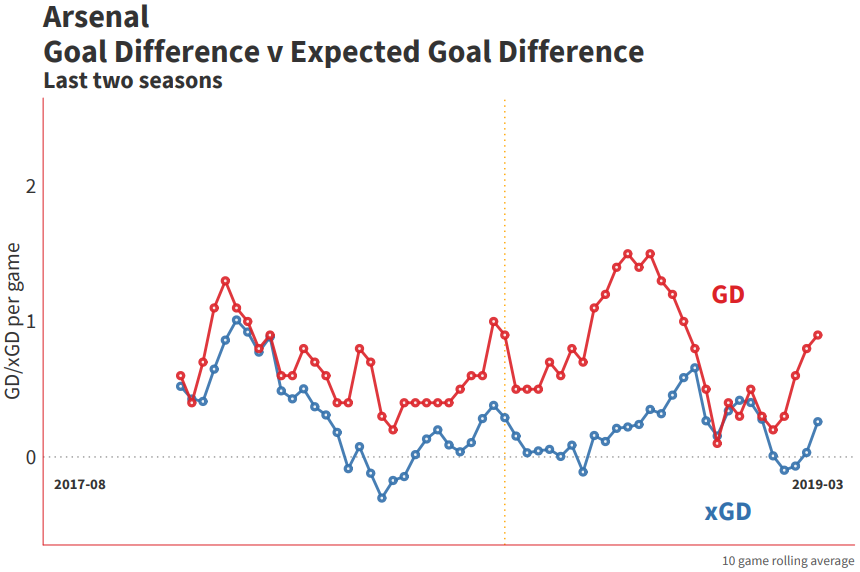 The question thus becomes about sustainability. It’s on the attacking side where things are really overheated, having scored 60 non-penalty goals from an expected return of 43.47. The first temptation is to wonder if Arsenal simply have very good finishers, with top scorers Pierre-Emerick Aubameyang and Alexandre Lacazette often thought of as among the best marksmen in Europe. The pair are only a tick ahead of where the chances they’ve taken would expect them to be.
The question thus becomes about sustainability. It’s on the attacking side where things are really overheated, having scored 60 non-penalty goals from an expected return of 43.47. The first temptation is to wonder if Arsenal simply have very good finishers, with top scorers Pierre-Emerick Aubameyang and Alexandre Lacazette often thought of as among the best marksmen in Europe. The pair are only a tick ahead of where the chances they’ve taken would expect them to be. 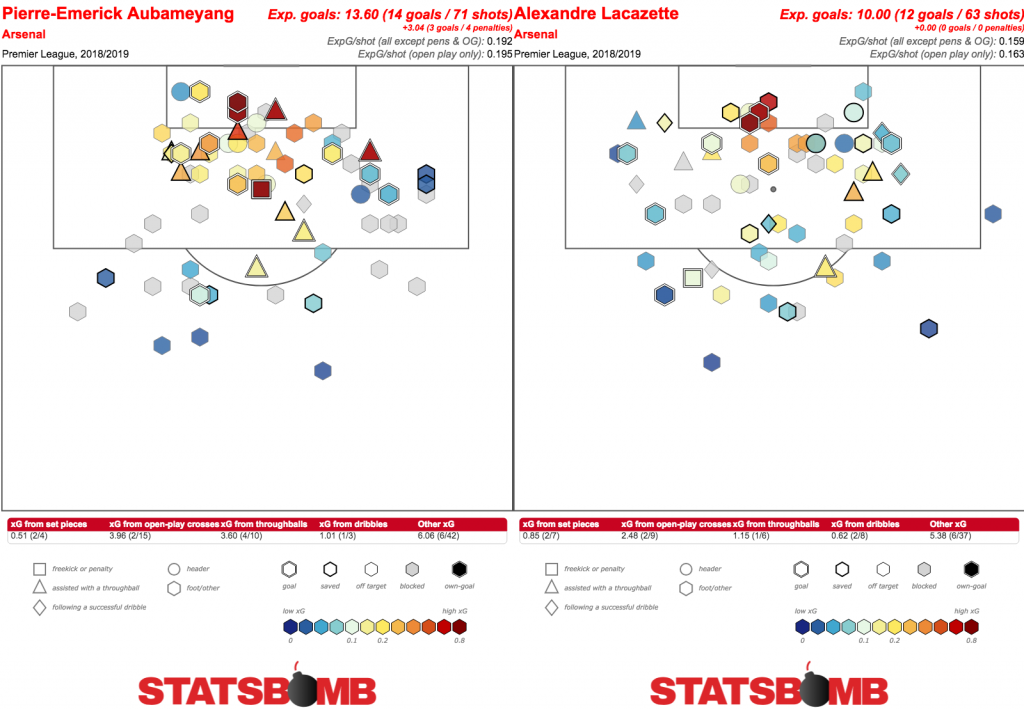 Nor is the answer to be found simply in set pieces, with the side beating expectations both there and in open play. The more one looks at the data, it seems like Arsenal aren’t consistently scoring certain “types” of goals so much as just converting very well across the board. Add in that sides managed by Emery do not have a reputation for breaking xG models (see: Favre, Lucien), and the suspicion is that this trend will not last forever. Defensively, the overperformance is more modest (conceded 33 non-penalty goals from a pre-shot xG of 37.53), and can be put down in no small part to the excellent form of goalkeeper Bernd Leno.
Nor is the answer to be found simply in set pieces, with the side beating expectations both there and in open play. The more one looks at the data, it seems like Arsenal aren’t consistently scoring certain “types” of goals so much as just converting very well across the board. Add in that sides managed by Emery do not have a reputation for breaking xG models (see: Favre, Lucien), and the suspicion is that this trend will not last forever. Defensively, the overperformance is more modest (conceded 33 non-penalty goals from a pre-shot xG of 37.53), and can be put down in no small part to the excellent form of goalkeeper Bernd Leno. 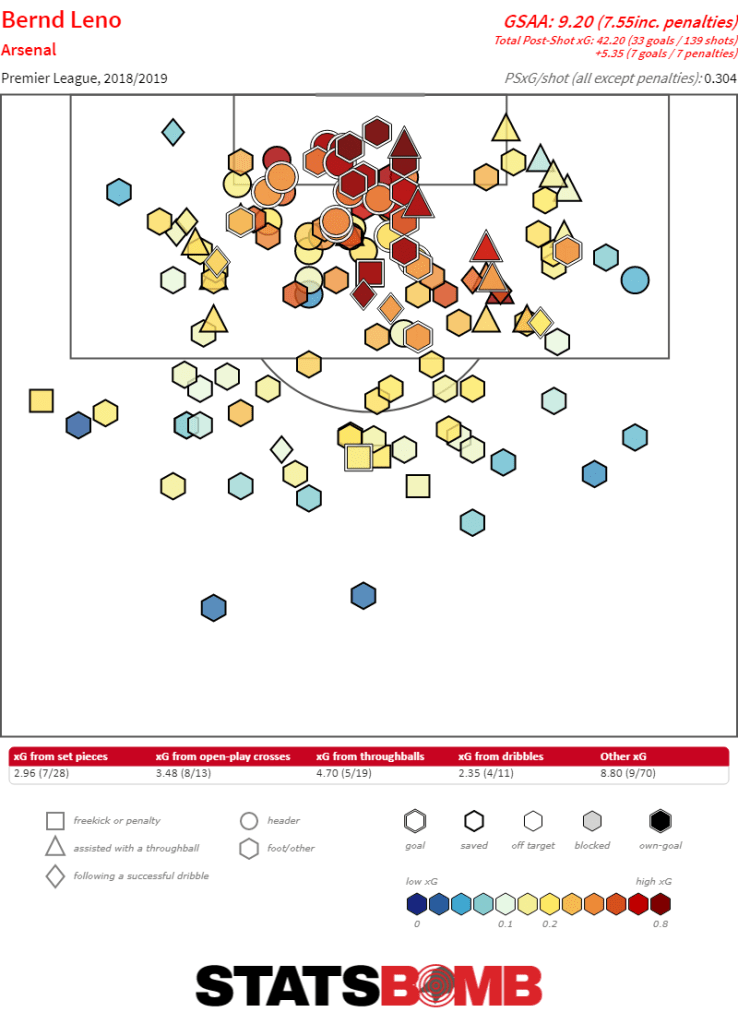 StatsBomb’s shot stopping metrics have Leno as the best ‘keeper in the Premier League this season. Considering his general reputation in Germany, this seems to be quite the uptick in form. Whether this is a more accurate picture of his ability, a genuine improvement, or just a good run is to be determined. But the signs so far look good that Arsenal have a long term solution to what was often a problem position under Wenger.
StatsBomb’s shot stopping metrics have Leno as the best ‘keeper in the Premier League this season. Considering his general reputation in Germany, this seems to be quite the uptick in form. Whether this is a more accurate picture of his ability, a genuine improvement, or just a good run is to be determined. But the signs so far look good that Arsenal have a long term solution to what was often a problem position under Wenger. 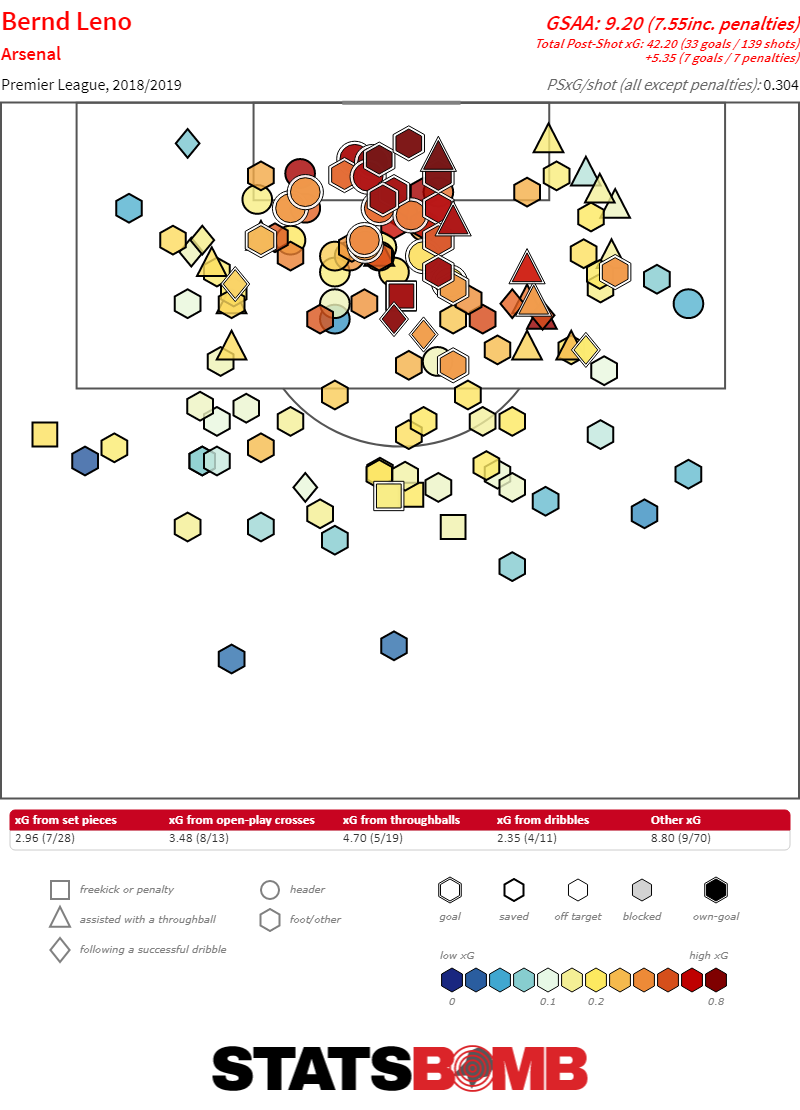 Ok, so it seems like Arsenal haven’t played substantially better this season than last. But, you’re probably saying, this is the first season of a radical break from how things have been done at the club for the past two decades. It’s not about playing well right now, but building something that can be successful in the long term. So let’s take a look at the stylistic changes Emery is implementing. “Pressing” was something of a buzzword when Emery was appointed in the summer. Perhaps this was because of the success that fellow Premier League managers Pep Guardiola, Jürgen Klopp and Mauricio Pochettino have had with variations on the approach, or then Arsenal chief executive Ivan Gazidis’ description of Emery’s “progressive style of football”. A proactive, high pressing approach was what became expected, but it is not what has manifested. Arsenal are actually allowing opposition sides to complete slightly more passes on average (9.61) before making a defensive action than they did last season (8.96). When looking at their defensive distance, it has continued to largely fluctuate, and Arsenal are in fact doing their defending from slightly deeper positions than last year.
Ok, so it seems like Arsenal haven’t played substantially better this season than last. But, you’re probably saying, this is the first season of a radical break from how things have been done at the club for the past two decades. It’s not about playing well right now, but building something that can be successful in the long term. So let’s take a look at the stylistic changes Emery is implementing. “Pressing” was something of a buzzword when Emery was appointed in the summer. Perhaps this was because of the success that fellow Premier League managers Pep Guardiola, Jürgen Klopp and Mauricio Pochettino have had with variations on the approach, or then Arsenal chief executive Ivan Gazidis’ description of Emery’s “progressive style of football”. A proactive, high pressing approach was what became expected, but it is not what has manifested. Arsenal are actually allowing opposition sides to complete slightly more passes on average (9.61) before making a defensive action than they did last season (8.96). When looking at their defensive distance, it has continued to largely fluctuate, and Arsenal are in fact doing their defending from slightly deeper positions than last year. 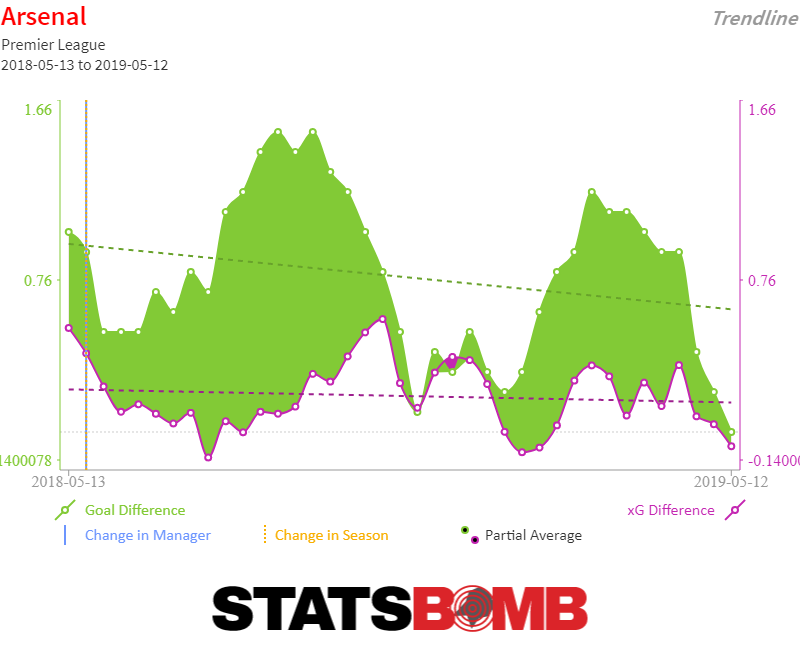 What we are seeing more of, though, is aggression. This has been felt in Arsenal’s performances this season, with many bringing out the usual cliches of “desire” and commitment” after the win against Manchester United, but it can also be seen in the data. The team have seen a 24% increase in aggressive actions (tackles, pressure events and fouls a team makes within 2 seconds of an opposition ball receipt). Similarly, there has been a 12% increase on the percentage of opponent passes that are “aggressively” pressed by Arsenal. Emery might not necessarily be having his side press more or higher up the pitch, but when they do it, they apply an aggression that wasn’t previously seen. On the flip side, some of the nice passing everyone associated with the Wenger era seems to be falling away under the Spaniard. Passes inside the opposition box has traditionally been an “Arsenal stat”, seeing the side generally lead the league for some time (though this was before the arrival of Pep Guardiola). There has been a 12% decrease in Arsenal’s volume of passes in the box, with Manchester City putting them well in the shade. This is the essential transition to Emery in a nutshell: harder, more aggressive, uglier. We can see this in the players who are and are not thriving this season. Ainsley Maitland-Niles, for example, has filled in for Héctor Bellerín at right back and taken to the role like a duck to water. His very active form of defending seems ideal for this side, perhaps even more so than Bellerín, who still seems to be more comfortable with the Wenger style of play.
What we are seeing more of, though, is aggression. This has been felt in Arsenal’s performances this season, with many bringing out the usual cliches of “desire” and commitment” after the win against Manchester United, but it can also be seen in the data. The team have seen a 24% increase in aggressive actions (tackles, pressure events and fouls a team makes within 2 seconds of an opposition ball receipt). Similarly, there has been a 12% increase on the percentage of opponent passes that are “aggressively” pressed by Arsenal. Emery might not necessarily be having his side press more or higher up the pitch, but when they do it, they apply an aggression that wasn’t previously seen. On the flip side, some of the nice passing everyone associated with the Wenger era seems to be falling away under the Spaniard. Passes inside the opposition box has traditionally been an “Arsenal stat”, seeing the side generally lead the league for some time (though this was before the arrival of Pep Guardiola). There has been a 12% decrease in Arsenal’s volume of passes in the box, with Manchester City putting them well in the shade. This is the essential transition to Emery in a nutshell: harder, more aggressive, uglier. We can see this in the players who are and are not thriving this season. Ainsley Maitland-Niles, for example, has filled in for Héctor Bellerín at right back and taken to the role like a duck to water. His very active form of defending seems ideal for this side, perhaps even more so than Bellerín, who still seems to be more comfortable with the Wenger style of play.  Youngster Mattéo Guendouzi has enjoyed a terrific debut season at the club, with a combination of decent defensive output with a decent creative passing threat suggesting the 19 year old could go on to have the full skillset.
Youngster Mattéo Guendouzi has enjoyed a terrific debut season at the club, with a combination of decent defensive output with a decent creative passing threat suggesting the 19 year old could go on to have the full skillset. 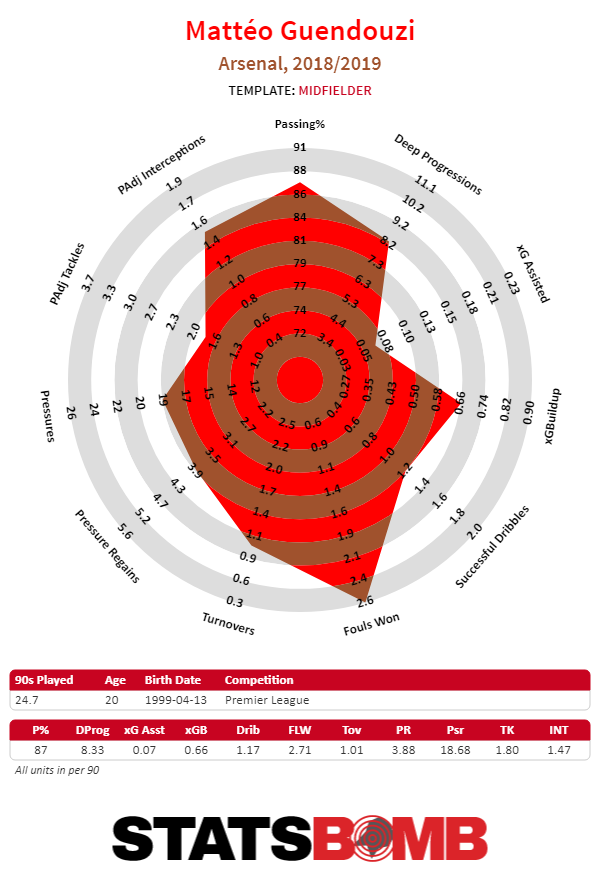 But of course, if we’re talking about players not doing so well under Emery, there’s no place to go but Mesut Özil. Always treated with suspicion by some, the attacking midfielder nonetheless functioned as a key cog in keeping things fluid in the final third for Wenger. It does, unfortunately, seem as though things might be a little to frantic for him under Emery. Having started just three league games since the turn of the calendar year despite reportedly being the club’s highest earner, it’s obvious the manager isn’t sold, and the numbers certainly point toward him having less influence on the game than last season. There are serious squad construction questions to be asked of why his contract was renewed only for the new boss to decide he wasn’t convinced, but that is a brief that goes above Emery’s head.
But of course, if we’re talking about players not doing so well under Emery, there’s no place to go but Mesut Özil. Always treated with suspicion by some, the attacking midfielder nonetheless functioned as a key cog in keeping things fluid in the final third for Wenger. It does, unfortunately, seem as though things might be a little to frantic for him under Emery. Having started just three league games since the turn of the calendar year despite reportedly being the club’s highest earner, it’s obvious the manager isn’t sold, and the numbers certainly point toward him having less influence on the game than last season. There are serious squad construction questions to be asked of why his contract was renewed only for the new boss to decide he wasn’t convinced, but that is a brief that goes above Emery’s head.  That might get at Arsenal’s biggest problem right now. All the decisions taken at the club, since well before anyone currently involved arrived, have been geared towards Wenger’s methods. Emery is trying to introduce some new ideas to a squad accustomed to doing things a certain way. There are signs that his ideas are taking hold, even if it has not led to a substantial performance improvement, but it still feels too early to judge whether this is the correct course. Emery is turning a cruise ship around, and it will take time, but we can at least see that things are changing at Arsenal.
That might get at Arsenal’s biggest problem right now. All the decisions taken at the club, since well before anyone currently involved arrived, have been geared towards Wenger’s methods. Emery is trying to introduce some new ideas to a squad accustomed to doing things a certain way. There are signs that his ideas are taking hold, even if it has not led to a substantial performance improvement, but it still feels too early to judge whether this is the correct course. Emery is turning a cruise ship around, and it will take time, but we can at least see that things are changing at Arsenal.
2019
How Much Have Arsenal Changed Under Unai Emery?
By admin
|
March 14, 2019